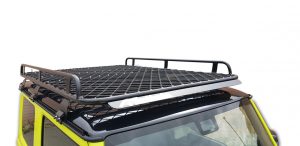Older car roof racks were made of bare stainless steel or aluminium. These each had their advantages, and both were fairly rust-resistant. Modern roof racks are an improvement, however. They use powder coatings to offer further protection against rust.
Aluminium Roof Racks
These were often used on a standard car roof rack. They were lightweight and fine for the moderate loads that were occasionally carried. Unless they were exposed to salt water (perhaps by fishing gear or surfboard) they would last for years with no rust.
Flat-Top Roof Racks
Heavy vehicles like 4WDs tended to carry heavier loads. So they required a heavy-duty roof rack. Being made of stainless steel or galvanized steel, this would weigh more than an aluminium roof rack, though this was hardly a problem as the heavy vehicle could handle the load. Under normal conditions, these stainless or galvanized steel would last very well. But they could rust if they suffered a deep scratch, or if the metal roof rack came into contact with a dissimilar metal. Moisture on stainless steel that contacts another metal will cause some rust. In some cases the bolts there was rust near the bolts that held the roof rack in place because the bolts and the roof rack were dissimilar metals
Roof Racks in Melbourne, Sydney, and Perth
Powder-coated roof racks take rust resistance to the next level. The powder coating not only prevents rust from damaging the actual rack but also prevents rust where the roof rack contacts other metals. As an added bonus, the powder coating can be a much more pleasing colour than bare metal.

Flat Top roof racks for 4WD
A custom roof rack is the best option for any vehicle that needs that extra storage space. The advantage of a custom-designed rack is that it will fit your vehicle exactly, maximising storage space and ensuring a secure fit.




